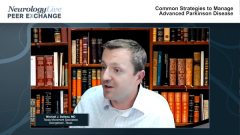
Advanced Parkinson Disease: Discussions With the Patient
A discussion about how to educate and speak with patients with advanced Parkinson disease.
Episodes in this series

Adolfo Ramirez-Zamora, MD: I think there’s a need, and I think it’s helpful for us sometimes to take the time to try to educate the patient as they’re transitioning [to advanced Parkinson]. Maybe they’re having more trouble with motor fluctuations, or they start to, or even beyond that, in general nonmotor and motor symptoms, it pays dividends to spend the time upfront educating the patient about what to expect. Commonly, patients will come [in] and then we try to talk about these terms and say, “Are your medications connecting dose to dose? Are you on? Are you having dose failures?” The patients may say, “I have a tremor.” But they’re referring to dyskinesia or vice versa. “My medications are not working,” and they’re widely dyskinetic because of erratic absorption. Would you comment a little bit on how that conversation goes in your clinic? How do you discuss and collect information about motor fluctuations? How much time do you spend educating [patients] about them? And what are the challenges when patients start developing motor fluctuations?
Joohi Jimenez-Shahed, MD: I actually have a set of questions that I ask, and sometimes if patients are having trouble understanding the concepts, I’ll even send them home with this list of questions. It really has to do with things like, when you take your medications, can you feel the effect? If you can feel the effect kicking in, how long does it take before those medications kick in? What are some things that you notice are different once those medications kick in, and then how long does that effect really seem to last before it wears off? When it does wear off, what are some of the things that you find harder to do, or what symptoms seem to be returning when those medications wear off? I’ll ask them if they’re aware of these on and off times, how good are the on times, are they able to do everything that they want to do; and if they’re having the off times, how bad are they, and what are some things that they might not be able to do when the medications are wearing off.
Then we turn our conversation a little bit to dyskinesia. If your medications kick in, do you start feeling any excessive involuntary movements? I give them some examples. These are movements that might show up when you’re talking or trying to have a conversation, maybe while standing in the kitchen. That’s another one that I commonly hear from patients, that they’re swaying when they’re standing and trying to do those types of activities as well. And if you’re having those dyskinesias, how bothersome are they? Are they something you can live with, or are they something that you feel like you need to have managed a little bit better?
So that’s kind of the progression of questions that I use to try to understand patients. Then, depending on what they tell me, if it’s an off-time issue, then we can direct our treatments towards managing their off times. If it is a “my meds aren’t kicking in well enough” issue, then we can talk about boosting their levodopa in some way, shape, or form. Or if it’s the dyskinesia, then we have dyskinesia management strategies, and there’s several of them. There are many different approaches that we can take depending on what we can identify as the main problem that they would like addressed.
Adolfo Ramirez-Zamora, MD: Terrific, great discussion. Ari, I would like to ask you if you can say a few words about how common these motor fluctuations are. What are the factors or potential causes that are associated with these motor fluctuations, and what are the initial strategies that are commonly used in clinic for these concerns?
Aristide Merola, MD, PhD: Absolutely. The problem is related to the fact that levodopa has a very short half-life. Different from other medications, levodopa has a half-life of 90 minutes. We also have another problem which is that levodopa is absorbed in the duodenum. It’s a specific part of the bowel that is not reached immediately. We know that the pills the patients take sit in their stomach for a little bit before the stomach empties, and then the pills will transition to the duodenum. Only at that point the medication is absorbed. So between taking the pill and actually having the effect of the pill, usually there is a delay of approximately 30 to 40 minutes. Sometimes patients are confused about this. They feel like when they take the pill, immediately they don’t feel well. It’s not really because the pill causes that, it’s because the previous dose is actually wearing off and the new dose hasn’t kicked in yet. So it’s important to educate patients about this.
At that point, what happens is that once the pill kicks in eventually the effect only lasts for a few hours. This is something that patients start to develop over time. The thing is the residual neurons still have a little bit of buffer capacity. In the first years of Parkinson disease, the medications have a longer effect because they supplement the endogenous production of dopamine. But then later, once the neurons that are residual in the brain progressively decrease, at that point the entire motor outcome is based on the plasma level of levodopa, so patients become more sensitive to the plasma levels. The fact is that patients develop motor fluctuations, so these daily ups and downs after a few years of taking levodopa also created a lot of misconceptions.
The first [misconception] was that the levodopa itself can cause motor fluctuations. So we have to educate [patients] and explain that it’s not taking levodopa that creates these motor fluctuations but the progression of the disease. The more the disease progresses the more it becomes important to fractionalize levodopa over multiple daily administrations in order to try to keep a constant plasma level. This is not always simple to achieve with just pills, and that’s where device-aided therapy comes in. The motor fluctuations also can cause significant nonmotor symptoms. Levodopa wearing off can cause anxiety, pain, and a lot of symptoms that can cause distress. Many patients fear this moment, so they may be constantly anxious of when the medication is going to wear off, and if this happens in public—maybe you’re in the grocery store—this can be a problem. So, they are very anxious, and they say, “How can I manage that situation?” That’s when the secondary damage related to Parkinson disease occurs. They withdraw from their social activities. They have social adjustments because they’re worried about what can happen. That’s exactly the point where we have to consider device-aided therapies. We have to consider therapies that can minimize this advanced phenomenon.
Adolfo Ramirez-Zamora, MD: Thank you all for watching this Neurology Live® Peer Exchange. If you enjoyed the content, please subscribe to our eNewsletter to receive upcoming peer exchanges and other great content right in your inbox. Thank you so much.
Transcript Edited for Clarity
Newsletter
Keep your finger on the pulse of neurology—subscribe to NeurologyLive for expert interviews, new data, and breakthrough treatment updates.














